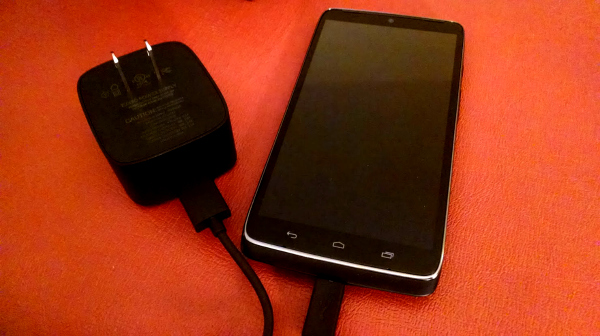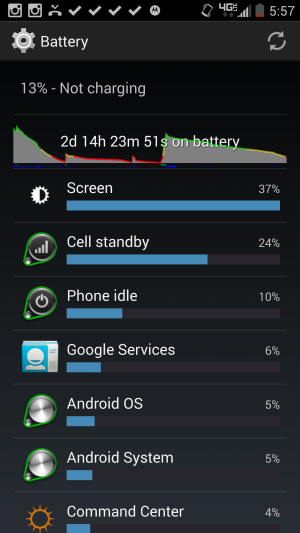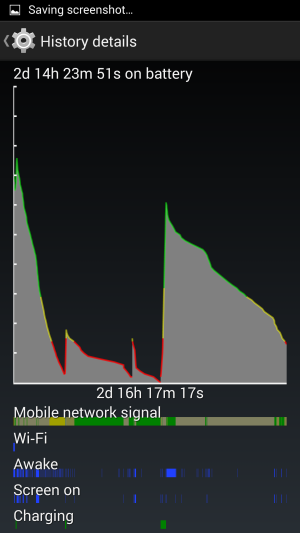Since 2013, Motorola has started to dominate the smartphone market with its eye on utility and design over massive specs and endless software features. To be specific, I’m talking about Moto, Motorola’s sensible smartphone lineup. The G, the M, and the X (2013 and 2014 versions). These are incredibly useful and practical devices, all with reasonable no-contract prices. But this fall, Motorola released a mutant amalgamation of its DROID and Moto lineup, and it’s called the DROID Turbo. The Turbo is a beast of massive specs and a humongous battery, a grandiose design of ugly and aesthetic all packed into one very heavy 5.2” package, all the while keeping hold of Moto’s best software features. And lucky for you, we’re reviewing this monster for you below so Verizon Wireless and likely George Lucas (DROID-trademark owner) can make dimes on every model sold.
Design
The DROID Turbo is an odd duck because despite it having a premium-looking aluminum rim around its 5.2” screen, it’s a fairly ugly device. It also has a bit of a jutting chin at bottom. You will find three capacitive off-screen buttons at bottom and notice a front speaker at the top rim. In the right light, it’s a pretty shiny device. I’m not suggesting this is an atrocious phone, but it’s likely not to catch anyone’s eye for beauty either.
[slideshow_deploy id=’6644′]
Nevertheless, the back of the Turbo is unique in that it comes in either Kevlar or “Ballistic Nylon,” an interesting fabric innovation that gives it a more premium/futuristic colorful look. Many say they prefer the feel of the Kevlar over this fabric backing. For us, our review unit came with the Kevlar. It is reminiscent of generations of DROID products before it, and it was boring if anything. Nylon at least makes the device stand out, and I’d find it much more interesting than the basic model any day.
The back also has Motorola’s M logo in the ergonomic index finger spot along with a 21-megapixel camera just above, in the center of the device. The camera is surrounded by its two flash LEDs. None of this is an off-shoot from any of the Moto smartphone designs.
Specs
The real story of the Turbo is nothing about its aesthetics. It’s about the hardware inside. The specs actually dwarf the Moto X which came out shortly before the Turbo. It has a beautiful 5.2” AMOLED with 1440 x 2560 resolution and 565 ppi, compared to the Moto X’s 423. Can you tell the difference? Unlikely, but it’s one of many differences in the tape measure game. The Turbo also houses a quad-core 2.7 GHz Snapdragon 805 with an Adreno 420 and 3GB of RAM. You should probably let that sink in for a moment, because despite this device being 5.2”, its processing speed matches that of the Samsung Galaxy Note 4, a 5.7” device.
It also has the largest battery ever. It’s 3900 mAh, a battery so big we don’t recall any smartphone housing something so ridiculous. This battery is also capable of supercharging like the Moto X and other devices including the Note 4. This means Qualcomm’s quick charger plug comes with the phone, promising incredibly fast-paced recharging, a definite bonus in 2014. The DROID Turbo also comes capable with wireless charging, which is an exciting promise for future phones. Last year at CES, Qi (inductive power standard) had promised dozens of models coming out with wireless charging in 2014. Weirdly, we have yet to see very many besides Nokia devices include wireless charging standard.
The Turbo is also a storage hound. Remember the days 8GB was the best you could get? Thankfully, the Turbo comes with 32 and 64GB of internal storage for all your Insta/Snapchat needs. In essence, this device is a measuring stick to show off to your friends. It’s blazing fast. 2.7 GHz of speed is absolutely absurd along with its life-long battery that weighs down the Turbo at 176 g/6.21 oz. Who needs a brick in their purse when could knock someone out with this?
Battery
Let’s talk about this 3900 mAh battery for a moment. Like the Moto X this comes with a Qualcomm Quick Charge 2.0 adapter, which allows you to charge the battery within two hours, and up to 8 hours worth of juice in just 15 minutes. In our tests, we found this actually quite accurate. Sometimes in 20 minutes we even reach 35% from dead, giving it about 11-12 hours battery life at estimate. But even if it wasn’t always true (sometimes the Turbo did not last the 8 hours promised from a 15-minute charge), 3900 mAh is just absurdly large. We could get 36 hours out of this device without a problem and at sometimes three days on standby alone. Using it more frequently definitely put a bigger dent in it, of course. Nevertheless, 24 hours is likely the benchmark of life here for a heavy user, and that’s not a bad deal when you can supercharge to 35% in 20 minutes or get a full charge in 2 hours.
For bar-hopping around DC, that late-night battery life is crucial, especially when all your friends have iPhones and you never remember a charger. We all know the lonely Android life, and with the Turbo, you’ll never feel alone again. Feel free, mock mock your friends looking for their iPhone 6 chargers, because you’ll never be in the dark with this DROID.
Software
As stated, the Turbo is an amalgamation of DROID and Moto features–hefty specs matched with the software utility of Moto devices. This means the famed features of quick notifications (Active Display), nearly stock Android (KitKat 4.44), embedded Google Now access, and non-confusing camera software are ever present.
As a Moto X (2013) owner, this was a familiar environment I loved. “Hello, DROID Turbo,” or a passphrase of your choice, allows you to use Google Now at a bark, and you can still shake the device (a defining Moto X feature) to open the camera. It’s a bit of a heavier shake than the original, but it’s still a satisfying way to quickly snapshot a moment. Active Display allows you to tap, wave over (with your hand), or even wiggle the screen to see what texts, emails, or app notifications you have at any given moment. For efficiency, it only utilizes the pixels on the screen needed to show you the time or whatever is happening. This is a godsend in meetings where it’s inappropriate to be on your phone, or if you’re in a hurry and just need a quick time check. You can see this used above in our video review.
Settings menus are user-friendly and not overly-complicated, so even your mom can figure out how to turn on pattern security or face detection. We did try face detection for a while, and it worked about 50% of the time, but having a face that always looks the same doesn’t hurt. One fun suggestion is to make the same goofy face to unlock it. Don’t you worry about the looks you get on the Metro, this inside joke is priceless. One fun new innovation added is the ability to double tap the home button to open an application of your liking. Whether you want to open the Camera or Google Maps, you have a plethora of choices for this awesome customizable setting.
As for bloat, there’s plenty of Verizon apps thrown in including DROID Zap which is a bit like a Verizon-branded tap application for sharing media with friends who also use the application. Most people probably won’t use any of these apps included, but thankfully with 32 or 64GB of storage, if you can’t remove them, you can at least wipe them off your home screens without a second thought.
Camera
The 21-megapixel camera on the Turbo squashes any other iteration of Moto or DROID devices. It’s actually a really, really awesome camera. The brand new Moto X only has a 13-megapixel shooter. Shots are clear, sharp, and well saturated and contrasted, making nearly any scene attractive. I wouldn’t put this in iPhone 5S or 6 territory, but it definitely wipes out lower-res options on the market. The only problem with it is the software. Like the Moto X before it, taking individual shots has a bit of a focus lag to it. It’s good to note that taking multiple photos has the same initial lag, yet it can take 10 shots in mere seconds. we should also note default wide shots are shot in 15 megapixels rather than the 21 in 4:3.
[slideshow_deploy id=’6660′]
Still, the photos turn out brilliant. It’s just a slight hiccup the previous and current Moto X have had since the beginning of Moto. With promises from carriers to upgrade the Turbo to Android Lollipop 5.0, it’s feasible fixes could be in place to cut down this photo lag, but I wouldn’t hold my breath. As for video, you can shoot in 4K with the rear camera and it turns out equally amazing.
You can see some of the shots I took with the Turbo during our review period above and in our video review above. In low light, photos would produce a bit of noise sometimes, but generally each picture was as satisfying as the next. Blue skies and nature shots really popped, no matter how dingy they were in real life. As for the 2.0-megapixel front-facing camera, it’s a great way to check out your blemishes and see how oily you really do look today. In other words, the Turbo’s selfie cam has great attention to detail, but it might not be the ones you like.
General Use
The Turbo is a great phone on the inside. The downfall is how heavy those internals make the device. Carrying this around was definitely a burden at 6.21 oz. For comparison, the Moto X weights a bit over an ounce less (5.08), but it’s also sleeker than the .44” thickness of the Turbo. It’s definitely a bulge in the pocket, but if you’re the type to throw your phone in a bag or purse, perhaps you don’t care anyway.
This is all to blame on that giant 3900 mAh battery. But some of the best parts of this phone are also affiliated. The supercharger and giant battery are a match made in heaven for the impatient and ever-connected. Never did I worry of killing the DROID during this review. Standby would get this device three entire days at times. During others when using it heavily on and off, 36 hours was not difficult to muster. And if the Turbo did die, that Supercharger amped the device enough in 20-30 minutes without a problem.
While the battery size is an amazing addition, the innovation of the supercharging is even more so. 15 minutes to get 8 hours of juice is something that deserves mad respect, and it was definitely useful for long days and nights away from home. It did not always live up to the hype, but even 5 additional plugged minutes can get you a reasonable amount of play time with the Turbo.
The software is my favorite part of the Turbo and every other Motorola Moto software-included phone. Active Display notifications and native Google Now access with Moto Voice are priceless features. Shake cam is also the coolest innovation to phones since capacitive screens. In addition, constantly up to date software is a must have if you’re going to get an Android, and thankfully Motorola, Verizon and Google do these devices well with Lollipop updates being promised shortly.
Texting on the device is actually fine with Swype type. I had my reservations on 5.2” but it wasn’t the girth of the phone that made its use difficult, it was the weight. I’d much prefer a 4.7”-5” handset over the Turbo nonetheless, because it was personally a bit of a pain to reach around. That said, the AMOLED was really lovely to look at. Text was clear, videos played brilliantly, and reviewing photos looks better than on your laptop with that high pixel density.
Lastly, the only major issue I had with the Turbo (Besides the heft) was the fact it’s just so damn clingy. Fingerprints, dust and food crumbs were all I could ever see on the Turbo. No matter how much I cleaned it, I couldn’t even get a nice clean shot of it in our video review. If you’re going to get a Turbo, be sure carry a dust rag around with it.
Overview
At the end of the day, the Motorola DROID Turbo is a lot of things. In fact, it’s too many things. Unless you’re an intrepid smartphone gamer, the 2.7 GHz and 3GB of RAM is excessive for most people. In addition, 5.2” is a bit of girth to carry around, and let’s not forget the 3900 mAh battery, which is larger than any other smartphone battery on the market. This device is a beast. It’s exactly what Verizon has always intended at DROID to be, a spec-hound to show off to your friends and boast numbers.
That said, it’s also a device with some of the most useful and bare-bones Android software features on the market. Motorola’s Moto version of Android is as close to stock as it gets without making it over-complicated. Active display, shake to camera, Google Now, and the great settings menus will not go unloved on the Turbo. But if you don’t need all of high-end specs or even the battery, we recommend considering the Moto X (2014). You can pick up your own DROID Turbo exclusively at Verizon Wireless for $199.99 with a 2-year contract. We recommend searching around, as $99.99 options also pop up for the 64GB version. If you want it contract free, the Turbo runs at $649.99.
If you haven’t already, be sure to check out our full video review further up.



